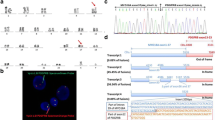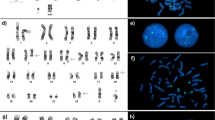Abstract
Aggressive angiomyxoma is a soft-tissue neoplasm with a predilection for the pelvic and perineal regions and a tendency to recur locally. Cytogenetic data on this tumor type are limited to five cases, three of which showed rearrangement of chromosomal bands 12q13–15. Molecular investigation of two of the tumors identified the HMGA2 gene as the target of the 12q rearrangements. However, the two previously analyzed tumors were different at the molecular level: in one, the rearrangement of 12q13–15 resulted in a fusion product, whereas, in the second case, the breakpoint was telomeric (3′) to the HMGA2, leaving the gene intact although expressed in its entire length. To shed more light on the pathobiology of aggressive angiomyxoma and to investigate the molecular mechanisms behind the involvement of the HMGA2 gene in this tumor type (fusion transcript vs deregulated expression), we investigated, cytogenetically and with molecular techniques, one such tumor which presented a t(11;12)(q23;q15) as the sole karyotypic aberration. FISH analyses demonstrated no structural alteration of HMGA2 at the cytogenetic level; however, expression of the full-length gene was detected molecularly.



Similar content being viewed by others
References
Ashar HR, Fejzo MS, Tkachenko A, Zhou X, Fletcher JA, Weremowicz S, Morton CC, Chada K (1995) Disruption of the architectural factor HMGI-C: DNA-binding AT hook motifs fused in lipomas to distinct transcriptional regulatory domains. Cell 82:57–65
Battista S, Fidanza V, Fedele M, Klein-Szanto AJ, Outwater E, Brunner H, Santoro M, Croce CM, Fusco A (1999) The expression of a truncated HMGI-C gene induces gigantism associated with lipomatosis. Cancer Res 59:4793–4797
Begin LR, Clement PB, Kirk ME, Jothy S, McCaughey PB, Ferenczy A (1985) Aggressive angiomyxoma of pelvic soft parts: a clinicopathologic study of nine cases. Hum Pathol 16:621–628
Betz JL, Meloni AM, U’Ren LA, Moore GE, Sandberg AA (1995) Cytogenetic findings in a case of aggressive angiomyxoma of the vaginal wall. Cancer Genet Cytogenet 84:157
Blandamura S, Cruz J, Faure VL, Machado PI, Ninfo V (2003) Aggressive angiomyxoma: a second case of metastasis with patient’s death. Hum Pathol 34:1072–1074
Borrmann L, Wilkening S, Bullerdiek J (2001) The expression of HMGA genes is regulated by their 3’UTR. Oncogene 20:4537–4541
Broberg K, Tallini G, Hoglund M, Lindstrand A, Toksvig-Larsen S, Mertens F (2001) The tumor-associated gene HMGIC is expressed in normal and osteoarthritis-affected synovia. Mod Pathol 14:311–317
Clatch RJ, Drake WK, Gonzales JG (1993) Aggressive angiomyxoma in men. Arch Pathol Lab Med 117:911–913
Dahlen A, Mertens F, Rydholm A, Brosjo O, Wejde J, Mandahl N, Panagopoulos I (2003) Fusion, disruption, and expression of HMGA2 in bone and soft tissue chondromas. Mod Pathol 16:1132–1140
Fetsch JF, Stenman G (2002) Tumors of uncertain differentiation. In: Fletcher CDM, Unni KK, Mertens F (eds) Tumours of soft tissue and bone: pathology & genetics. IARC, Lyon, pp 189–190
Gattas GJ, Quade BJ, Nowak RA, Morton CC (1999) HMGIC expression in human adult and fetal tissues and in uterine leiomyomata. Genes Chromosomes Cancer 25:316–322
Horsman DE, Berean KW, Salski CB, Clement PB (1991) Aggressive angiomyxoma of the pelvis: cytogenetics findings in a single case. Cancer Genet Cytogenet 56:130–131
Mitelman F (ed) (1995) ISCN: an international system for human cytogenetic nomenclature. S. Karger, Basel
Kazmierczak B, Dal Cin P, Wanschura S, Bartnitzke S, Van Den Berghe H, Bullerdiek J (1998) Cloning and molecular characterization of part of a new gene fused to HMGIC in mesenchymal tumors. Am J Pathol 152:431–435
Kazmierczak B, Wanschura S, Meyer-Bolte K, Caselitz J, Meister P, Bartnitzke S, Van de Ven W, Bullerdiek J (1995) Cytogenic and molecular analysis of an aggressive angiomyxoma. Am J Pathol 147:580–585
Kearny L, Hammomd DW (2001) Molecular cytogenetic technologies. In: Rooney DE (ed) Human cytogenetics—malignancy and acquired abnormalities. Oxford University Press, Oxford pp 129–163
Kenny-Moynihan MB, Hagen J, Richman B, McIntosh DG, Bridge JA (1996) Loss of an X chromosome in aggressive angiomyxoma of female soft parts: a case report. Cancer Genet Cytogenet 89:61–64
Ligon AH, Moore SD, Parisi MA, Mealiffe ME, Harris DJ, Ferguson HL, Quade BJ, Morton CC (2005) Constitutional rearrangement of the architectural factor HMGA2: a novel human phenotype including overgrowth and lipomas. Am J Hum Genet 76:340–348
Mandahl N (2001) Methods in solid tumors cytogenetics. In: Rooney DE (ed) Human cytogenetics—malignancy and acquired abnormalities. Oxford University Press, Oxford, pp 165–203
McCluggage WG (2005) A review and update of morphologically bland vulvovaginal mesenchymal lesions. Int J Gynecol Pathol 24:26–38
Mecucci C, Rosati R, Starza RL (2002) Genetic profile of acute myeloid leukemia. Rev Clin Exp Hematol 6:3–25
Nilsson M, Panagopoulos I, Mertens F, Mandahl N (2005) Fusion of the HMGA2 and NFIB genes in lipoma. Virchows Arch 447:855–858
Nucci MR, Fletcher CD (2000) Vulvovaginal soft tissue tumours: update and review. Histopathology 36:97–108
Nucci MR, Weremowicz S, Neskey DM, Sornberger K, Tallini G, Morton CC, Quade BJ (2001) Chromosomal translocation t(8;12) induces aberrant HMGIC expression in aggressive angiomyxoma of the vulva. Genes Chromosomes Cancer 32:172–176
Panagopoulos I, Mertens F, Domanski HA, Isaksson M, Brosjo O, Gustafson P, Mandahl N (2001) No EWS/FLI1 fusion transcripts in giant-cell tumors of bone. Int J Cancer 93:769–772
Quade BJ, Weremowicz S, Neskey DM, Vanni R, Ladd C, Dal Cin P, Morton CC (2003) Fusion transcripts involving HMGA2 are not a common molecular mechanism in uterine leiomyomata with rearrangements in 12q15. Cancer Res 63:1351–1358
Reeves R (2001) Molecular biology of HMGA proteins: hubs of nuclear function. Gene 277:63–81
Sambrook J, Fritsch EF, Maniatis T (1989) Molecular cloning: a laboratory manual. Cold Spring Harbor Laboratory, Cold Spring Harbor
Schoenberg FM, Ashar HR, Krauter KS, Powell WL, Rein MS, Weremowicz S, Yoon SJ, Kucherlapati RS, Chada K, Morton CC (1996) Translocation breakpoints upstream of the HMGIC gene in uterine leiomyomata suggest dysregulation of this gene by a mechanism different from that in lipomas. Genes Chromosomes Cancer 17:1–6
Schoenmakers EF, Wanschura S, Mols R, Bullerdiek J, Van Den Berghe H, Van de Ven WJ (1995) Recurrent rearrangements in the high mobility group protein gene, HMGI-C, in benign mesenchymal tumours. Nat Genet 10:436–444
Siassi RM, Papadopoulos T, Matzel KE (1999) Metastasizing aggressive angiomyxoma. N Engl J Med 341:1772
Tkachenko A, Ashar HR, Meloni AM, Sandberg AA, Chada KK (1997) Misexpression of disrupted HMGI architectural factors activates alternative pathways of tumorigenesis. Cancer Res 57:2276–2280
Tsang WY, Chan JK, Lee KC, Fisher C, Fletcher CD (1992) Aggressive angiomyxoma. A report of four cases occurring in men. Am J Surg Pathol 16:1059–1065
Wilkinson EJ (2002) Premalignant and malignant tumors of the vulva. In: Kurman RJ (ed) Blaustein’s pathology of the female genital tract. Springer, Berlin Heidelberg New York, pp 132–133
Zhou X, Benson KF, Ashar HR, Chada K (1995) Mutation responsible for the mouse pygmy phenotype in the developmentally regulated factor HMGI-C. Nature 376:771–774
Acknowledgements
This work was supported by grants from The Norwegian Cancer Society, COST Action B-19—Molecular cytogenetics of solid tumors—Short-term Scientific Mission programme, and The Gunnar Nilsson’s Cancer Foundation.
Author information
Authors and Affiliations
Corresponding author
Rights and permissions
About this article
Cite this article
Micci, F., Panagopoulos, I., Bjerkehagen, B. et al. Deregulation of HMGA2 in an aggressive angiomyxoma with t(11;12)(q23;q15). Virchows Arch 448, 838–842 (2006). https://doi.org/10.1007/s00428-006-0186-5
Received:
Accepted:
Published:
Issue Date:
DOI: https://doi.org/10.1007/s00428-006-0186-5




